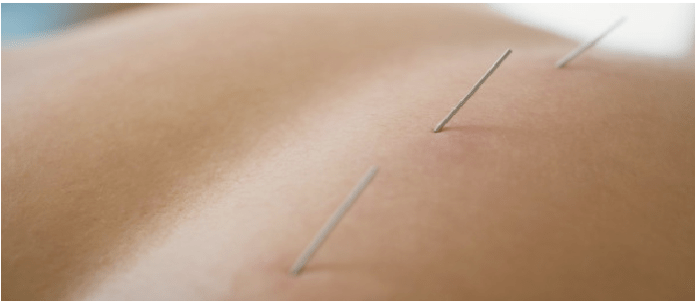Horry County locals have tried multiple pharmaceutical methods for treating issues that include migraines, joint and disc problems, tendinitis, spinal problems, whiplash, pelvic pain, tension headaches and more.
Americans have become keenly aware, however, to the downside of the long term use of addictive prescription medications and pharmaceuticals.
A non addictive, and highly effective treatment called functional dry needling offers locals a high quality of life, while eliminating dependence on addictive medications altogether.
Says Dr. Ashley J. Rolley, PT, DPT, Clinic Director of Myrtle Beach’s Fusion Rehab and Wellness, “Adding dry needling services to my practice has taken patient recovery to the next level.“
While the name of the procedure may sound intimidating, dry needling is safe, minimally discomforting and often an effective technique for patients with certain musculoskeletal presentations. Dry needling is a treatment performed by skilled, trained physical therapists, certified in the procedure. A thin monofilament needle penetrates the skin and treats underlying muscular trigger points for the management of neuromusculoskeletal pain and movement impairments.
Introduction: What is Dry Needling?
Dry needling is a treatment that involves the insertion of a very thin needle into trigger points or tight muscles of your body. The main purpose is to improve tissue healing and restore muscle function. Dry needling, also known as myofascial trigger point dry needling, is an alternative medicine technique similar to acupuncture. Dry needling is sometimes also known as intramuscular stimulation.
How Does Dry Needling Work?
Dry needling uses small skin pricks to stimulate a so-called “twitch” response in the muscle fibers in the taut bands of tissue, which then releases the spasm or trigger point that is causing the pain. When the needle is expertly inserted into the skin, the action stimulates nerve fibers.
What are the Benefits of Dry Needling?
Trigger point basics
A trigger point is a small area of tightly knotted muscle fibers. These knots develop when the muscle contracts and then doesn’t relax. In addition to creating a painful, hard, knot, the ongoing muscle contraction also pinches your nerves and blood vessels.
So, what causes a trigger point? These knots often develop due to:
- Repetitive muscle movements
- Lifting heavy weights or objects
- Direct injury
- Poor posture
- Tense muscles
- Chronic stress
Though knotted muscles commonly occur while you’re using your muscles, they can also develop from a lack of exercise, prolonged sitting, or time spent on bed rest. Without exercise, your muscles weaken and become more susceptible to developing a trigger point.
Four benefits of dry needling
Inserting an acupuncture-like needle into the trigger point relaxes the muscles, boosts blood flow, diminishes inflammation, and triggers a healing response. This treatment also improves nerve communication and activates the release of your body’s natural pain relievers.
The activities sparked by dry needling result in four benefits:
Get fast pain relief
Most people associate trigger points with knotted muscles in their shoulder, upper back, and neck. But the same problem can arise in any part of your body and be associated with many conditions, from low back and neck pain to joint pain and overuse injuries.
Your pain improves as the knot relaxes and blood flow improves. Better circulation means that painful, acidic wastes get carried away while your muscles receive the oxygen and nutrients they need to heal.
Many patients experience an immediate reduction in local and widespread pain after one dry needling session. Others may need several sessions to achieve optimum pain relief. Your treatment plan depends on the severity and number of trigger points.
Regain your range of motion
Few things stop you from moving like tight, painful muscles. If you have multiple trigger points, you may experience severely limited mobility. And when you’re not active, your muscles weaken and lose mass.
We often combine dry needling with a physical therapy program to rebuild your strength and fully restore your range of motion. Physical therapy also retrains your muscles, and this helps to prevent future trigger points.
Accelerate your recovery
Whether you suffered an injury or had surgery, moving your body is the best way to promote healing and speed up your recovery. Physical therapy is the primary treatment during your recovery. However, adding dry needling to physical therapy accelerates the process.
Improve chronic pain conditions
Dry needling goes a long way toward easing two chronic pain conditions, myofascial pain syndrome and fibromyalgia.
Myofascial pain syndrome occurs when trigger points develop in the fascia, a sheet of connective tissue that surrounds and supports all your muscles, nerves, blood vessels, and organs. Dry needling and physical therapy are among the best treatments for this chronic pain condition.
Fibromyalgia causes widespread pain and tenderness in your muscles. The pain affects the way you move, which in turn leads to trigger points. Patients who have fibromyalgia and get dry needling often experience significant improvement in their overall pain.
What Conditions Can be Treated with Dry Needles?
Dry needling is almost always used as a part of an overall plan that will likely include some type of exercise, manual therapy, heat therapy, and education. Dry needling is used to increase range of motion that may be limited due to muscle tightness or scar tissue. Dry needling may also treat:
- Joint problems
- Disk problems
- Tendinitis
- Migraine and tension-type headaches
- Jaw and mouth problems (such as temporomandibular joint disorders or TMD)
- Whiplash
- Repetitive motion disorders (like carpal tunnel syndrome)
- Spinal problems
- Pelvic pain
- Night cramps
- Phantom pain
- Post-herpetic neuralgia (pain left behind by shingles)
Conclusion: Why You Should Consider Getting a Dry Needle Treatment Today
We all know the side affects of long term use of prescription medicines.
Dry Needle Treatment is now provided locally by among the best professionals in the field.
You can reach Dr. Ashley J. Rolley, PT, DPT, Clinic Director of Myrtle Beach’s Fusion Rehab & Wellness by calling 843-294-0200.


